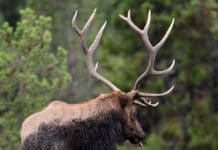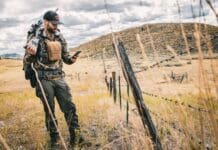My friend, Jared Bloomgren, is back with his final installment in his Spot-and-Stalk series (see Spot & Stalk Tactics & Spot & Stalk Part II.) He’s taken numerous animals with all weapon types using his favorite method. Show us how a pro gets it done, Jared!
The “Red Zone”…..a stage in every stalk that I CRAVE! One of my favorite quotes says it all and doesn’t need to be explained:
“Getting close to game undetected and maintaining self control while delivering a well placed shot are the true keys to bowhunting success.” -M.R. James
The Red Zone can vary on the terrain but for me it is usually the last 150 yards of the stalk. You are now within easy hearing distance of your quarry and often times may be within sight as you move. Picking the best possible route is a must during the final stages of your stalk.
There are a lot of things that need to come into consideration at this point. I check my bow, recheck my position to ensure I am on track, grab a quick drink and a stretch, pack comes off, I quiet my steps, enhance my senses, all while slowing down. Each movement is thought about with much more critique concentration. Moving like a wild animal with stealth is a must!
Paying attention to each step is a must and vital to achieving the overall end state. It always seems that when you take that one step and you weren’t watching is when you find that noise maker! A twig, pine cone, leaves, etc. I also watch for tree branches and brush that may rub against my equipment or gear and cause noise. Loose rocks can also be a nuisance. Picking a route that avoids anything that can make noise is crucial.
This pine cone could ruin months of planning and hard work
Another important factor is the wind/thermals. Have they changed? I have had to re-plan a stalking route many times because of these variants. Sometimes finishing the final stage of the stalk will require switching up the plan and making adjustments.
It doesn’t matter if I first spotted the animal from two miles or 200 yards—it’s the final 150 yards that usually takes the longest. Slowing the pace by 10x will help you move more quietly and will help calm your nerves. I try to get a visual on the animal to ensure that it hasn’t moved. Generally, they won’t move too far away but may change position to get back into shade if it is a warm day. If you cannot locate them just keep going with the stalk, nice and slow as if it is still bedded in the same spot. Keep your eyes peeled and be ready. Also watch for other animals that you may have not noticed while glassing.
When I get into position, I make sure that it is a shot that will be a good clean kill. I take another deep breath and look at my sticker on back of my arrow rest, “Stay calm- pick a spot.” It makes me focus and think about the task at hand.
There are different ways of getting the animal to stand. You could throw a rock or grunt but that notifies the animal that something else is in the immediate area. Most often they will bust out of their bed offering no shot.
I’ve learned that patience is always the best option and will yield you far more animals! I like to wait the animal out. Eventually it will stand to reposition or to feed. Being ready is a must! The animal will be more relaxed if you let them choose to stand and give you more time to take the shot. But be patient! It could take sometimes hours…but it could take just seconds! Nothing like gambling!
If you have been following my blog posts, you now have the tools to become a successful spot-and-stalk hunter. In my opinion, this method requires the most patience, pitting your wits against that of your prey. It is the hardest style of hunting but far more rewarding in the end! After 25+ years of spot-and-stalk hunting, I’m still learning something on every stalk that I can put into my bag of tools to use on a later hunt. Never stop learning and always keep advancing! Keep your mind open to always learning more! GOOD LUCK!




















thanks to Robby and Jared for your work on the blog.. always learning and changing tactics to be better at hunting. good hunting to all.
We are glad to help out Shawn!
Comments are closed.